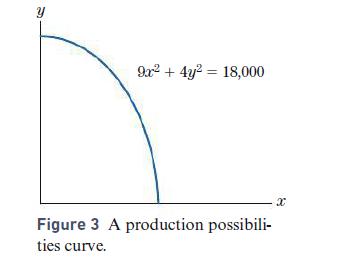Suppose that a firm makes two products, A and B, that use the same raw materials. Given
Question:
Suppose that a firm makes two products, A and B, that use the same raw materials. Given a fixed amount of raw materials and a fixed amount of labor, the firm must decide how much of its resources should be allocated to the production of A and how much to B. If x units of A and y units of B are produced, suppose that x and y must satisfy 9x2 + 4y2 = 18,000. The graph of this equation (for x ≥ 0, y ≥ 0) is called a production possibilities curve (Fig. 3). A point (x, y) on this curve represents a production schedule for the firm, committing it to produce x units of A and y units of B. The reason for the relationship between x and y involves the limitations on personnel and raw materials available to the firm. Suppose that each unit of A yields a $3 profit, whereas each unit of B yields a $4 profit. Then, the profit of the firm is P(x, y) = 3x + 4y. Find the production schedule that maximizes the profit function P(x, y).
Step by Step Answer:

Calculus And Its Applications
ISBN: 9780134437774
14th Edition
Authors: Larry Goldstein, David Lay, David Schneider, Nakhle Asmar





